Emergency evacuation and life boats, such as food tasting for everyday emergency hours etc JAL 's latest training equipment experience Reports

Passenger aircraft flying around the world with the lives of many people, once an emergency occurs, prompt and accurate correspondence is indispensable. In order to ensure such correspondence, airline companies carry out daily training for crews every day. At GIGAZINE in 2012Juries into the training facilities of JAL (Japan Airlines) and coverageI was told that this facility is now renewed and denser training is being conducted. This time, I had a chance to infiltrate the site of such training again, and in addition to the opportunity to experience some of the training and actually eat food prepared for emergency so I covered various things .
I came to JAL's training facility at Haneda Airport. The general people, about 10 minutes on foot from the Tokyo Monorail "New Maintenance Station Station", are located in places where few people turn their feet much.
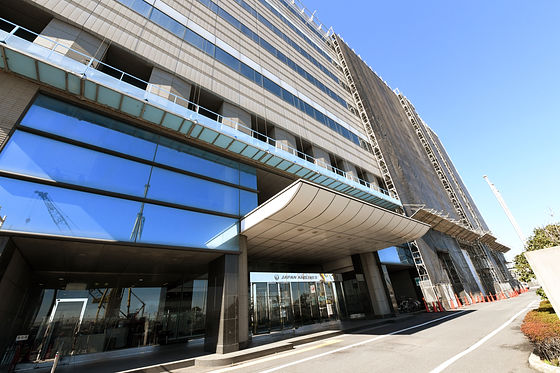
Facility names are "Technical Center" and "Education Center".

This is the facility that entered the building and reached through a long passage. In a space of the size and height as small as a gymnasium, equipment that imitates the fuselage of the airplane and three escape slides deployed from the door part are installed in total.

It is big enough to look up when you look down. Training can be carried out using the same slide as that loaded on the actual airplane.

Ms. Mikiko Kanno (left) and Ms. Furuhara Mariko (right) of the Safety Training Group of the Japan Airlines Room Education and Training Department, who conducted this explanation and demonstration. Both of us are working as cabin crew and are also involved in the safety training of the crew.

Also, Hiromiko Takagi, group leader of the group, talked about stories.
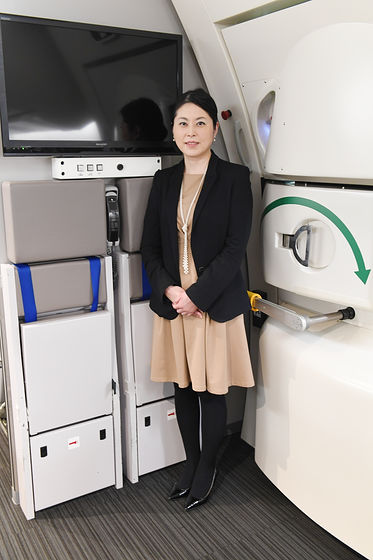
In this facility, training of cabin crewmen is carrying out 4 drills, "New Employee Training", "Type Training", "Return Training", and "Regular Rescue Drill". Training for newcomers who newly joined Japan Airlines to become cabin crews, training necessary for each model, training for returning crew members who were away from the site due to maternity leave or sickness treatment, and regular It is a training that is stipulated to take on the fact that it is done.
◆ New employee training
· Training for new recruits begins immediately after joining the company
· Training for domestic flight first (about 2 months)
· To conduct rescue exercises at an early stage in a series of curriculums. It keeps awareness, life as a flight attendant of Japan AirlinesSecurity personnelTo make you aware that
· Only those who have cleared the rescue exercise are allowed to enter service training by wearing uniforms
· After one year and one year and a half after working on domestic flights, I will be on international flights. In that case, after about 1 month of training is additionally carried out and then the actual boarding is started
· The subjects are JAL Group cabin attendants at home and abroad
◆ Type training
· Four types of aircraft operated by Japan Airlines "777 type", "787 type machine", "767 type machine" and "737 type machine" training conducted. "A350 aircraft" will be added to this from 2019
· First-time flight attendants are trained for 777, 767 and 737 aircraft. After that, when entering the international flight, we will train the 787 aircraft
· The objective is to learn differences in the size of the aircraft, differences in the shape of the door, differences in escape guidance procedures
· Training is usually carried out in 1 to 2 days, you can get tested and pass the aircraft by passing it
Return training
- As the flight attendant's qualification expires when moving away from office for more than half a year due to maternity leave, illness, injury, etc., training to restore this
· Depending on the period of absence, after training for about 5 days, return to office
◆ Regular Rescue Training
· Training that is established for maintaining qualification as a flight attendant once a year
· One month before and after the birth month as the base month, I have to receive this training during the last 3 months
· Practical skills and written exams will be held
· All the cabin crew members of the JAL Group are targeted, with about 5000 in Japan and 1,000 overseas, totaling over 6000
· In training, be sure to experience the escape sliding on the slide and also ride the boat assuming the time of landing
In addition to the above training, from November 2016, employee escape training for the workers in the group is progressing in sequence, and from April 2017 to all 20,000 JAL Group employees It is said that it is scheduled to start in earnest. Among them, participants learn how to help escape guidance as "donor" when traveling and taking an airplane in private. In the lecture class, students learn correspondence such as when landing, sudden depressurization, fuming smoke from the personal display attached to the seat, how to actually act in emergency in the subsequent practical skills, and "baggage Do not bring it out ", to say the same as a cabin crew like" Panic Control ", and to guide the passenger to slide when escaping, urge the user to leave the slide after escape, It seems to learn contents such as.
◆ Experience 1/4: I actually experienced escape · Part 1 "Case of sea escape"
When I heard the story, I actually experienced the escape procedure. First of all, a case where you use a pool with water set next to the aircraft to escape by wearing a life jacket when the plane arrives. Above the pool, a slide developed with air in advance is floated.

In addition, this equipment is often called "slide" for short, but the official name is "slide raft". This is a meaningful name for both "slide" which slides when escaping and "raft" floating in water like a boat.
Looking at "Slide Raft" from inside the aircraft is like this. It may be that you will see such a sight when actually arriving.

Before the escape experience begins, life jackets are handed one by one to each person. "If you can, I do not want to be indebted to Chorean ..." while thinking, my expectations for situations that I can not experience usually increase.
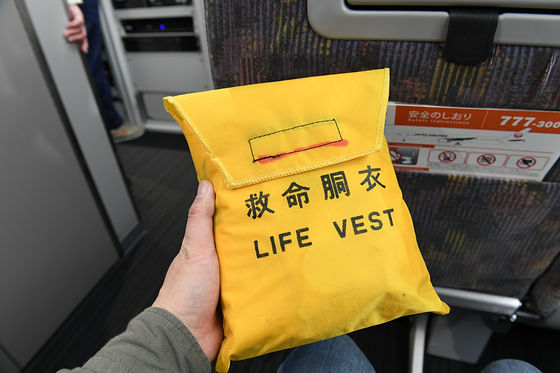
The same seat as the actual machine is used in the facility which is made in the same way as the actual airplane. And this unit controls the sound and lighting during training and creates an environment close to the actual situation. As will be described later, it is also possible to create a situation filled with smoke inside the aircraft by burning smoke.
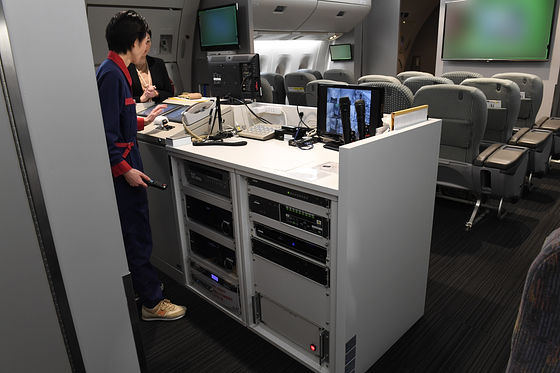
Training (experiences) started by saying that. On the indoor display, simulation images of computer landing scenes are flowed, and at the same time noise such as engine sound is played on the speaker.

I thought that it was safe to land on the runway ...... I suddenly diverted from the runway and jumped out of the airport premises and thrust into the sea. At this time as well, the noise that is clearly abnormal as "Zugogogo" is flowed from the speaker. Fujiwara sitting on the jumping seat for CA says to the passengers in a loud voice "Head down! Heads Down!"Announcing to take posture at emergency landing. This is one of the actions in an emergency called "shouting".
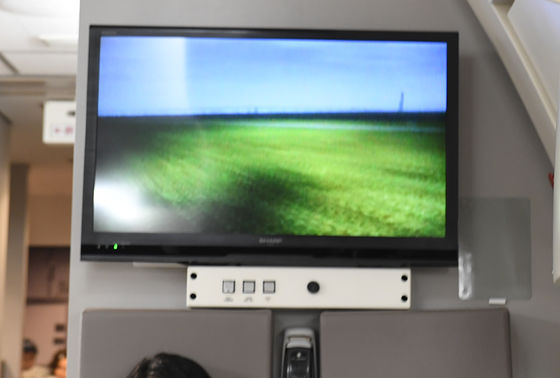
When the aircraft stops, Mr. Fujiwara next timeAll right! Be calm! Stay Calm!Shouting for passengers in Japanese and English. It is a very loud voice because it is required to give out the earth voice because the microphone can not be used.
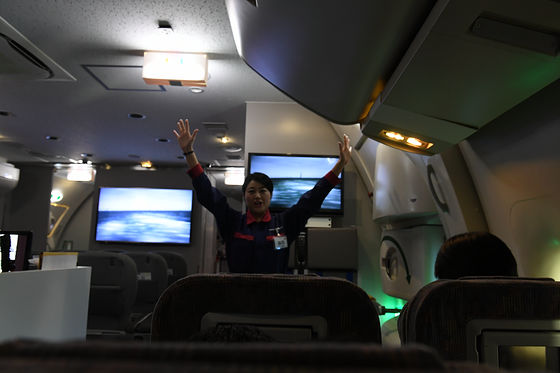
Then I urge you to take out the life jacket under the seat. At this time, the inside of the cabin is being darkened to lighten the emergency.
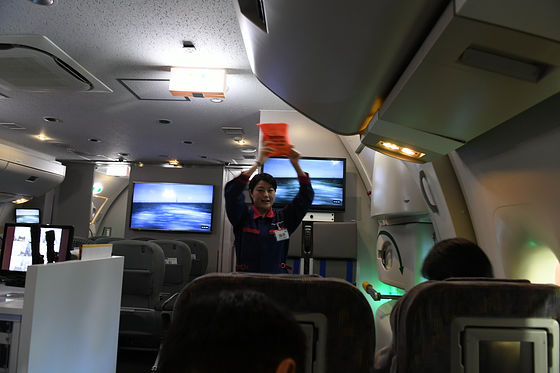
It shows the procedure to actually wear.
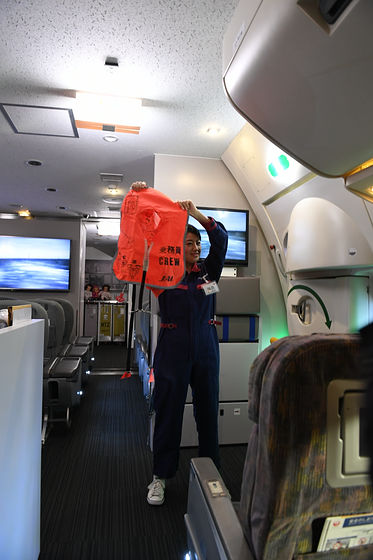
Wearing method, pass the head through the part where the hole is open, turn the two belts to the waist and attach it to the metal fitting in the part of the tummy. Wearing is completed by tightening the remaining belt in that state. There is also a life jacket for the baby in the cabin.
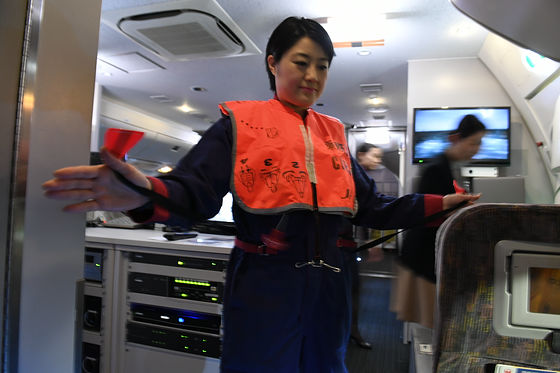
In addition, it is not good to inflate life jacket at this stage. The reason is that when the life jacket swells, the movements of the head are largely restricted, and even the feet can not be confirmed, which is because there is a danger of falling over by stumbing the legs during evacuation. In order to avoid this danger, it is important that when you escape, be sure to inflate the life jacket after coming in front of the door.
Next, Mr. Fujiwara confirmed the state of the outside from the window of the door and confirmed that no fire etc etc occurred outside the door.
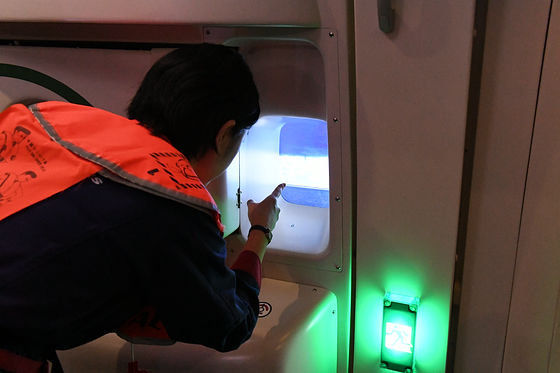
And check that the lever at the top of the door is in the "armored position". This is a work to ensure that the slide will automatically inflate when you open the door. Well, when an airplane lands, the announcement that the cabin crew should change the door mode to the disarmed position "that the cabin crew should flow is to prevent the slide from opening by setting this lever to" disarmed " thing. If you open the door by mistake as "Armed", it will develop into a rare case that the slide opens as "Bang!" At the parking lot of the airport.
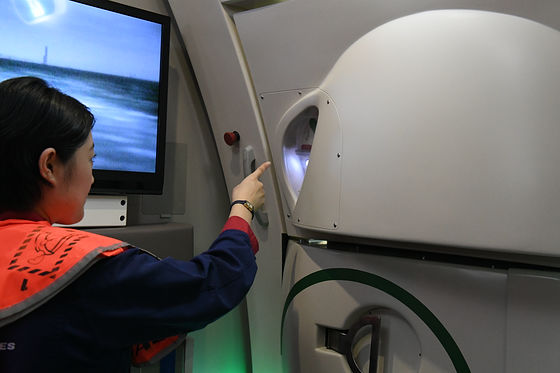
Suddenly, I noticed that there was a strange mark like a black and white pattern on the door.

This was a button for operating the "electronic shade" which electrically varies the light shielding ratio of the window adopted in the Boeing 787 type machine. This simulator device is not equipped with a real electronic shade, but in order to raise the reality more and improve the quality of the training, it was that a realistic button was drawn.

BySpaceaero 2
After checking the door, turn the large lever and open the door manually.
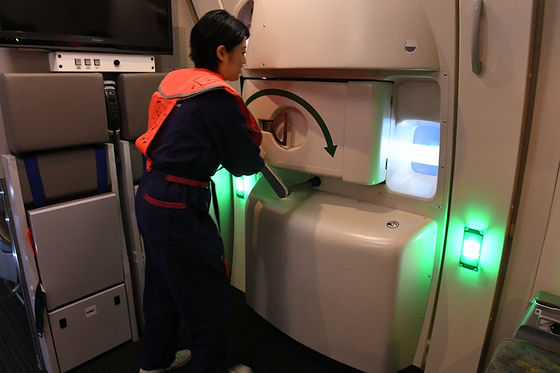
As the slide automatically expands when the door opens, check with the pointing. In this facility the slides are inflated beforehand, but training is done step by step.

Even if the slide does not open, it seems that it is equipped with a pulling belt for manually deploying.
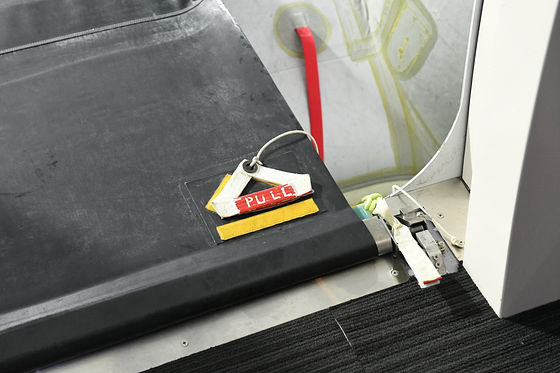
Block so that passengers do not go out by extending their hands until the slide is fully opened.
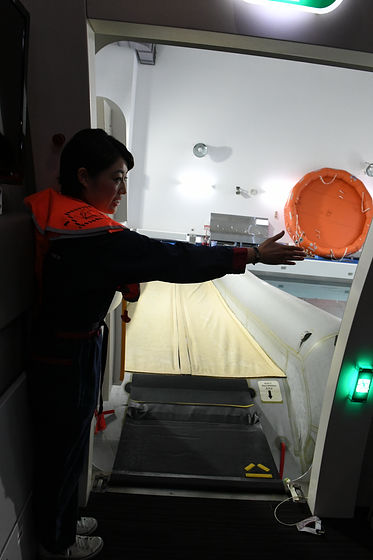
Once the slide is ready, it's time to escape by expanding the life jacket. When I stood in front of the door I pulled left and right straps, along with the sound "Pashee!", The life jacket swelled into a bang in a moment.
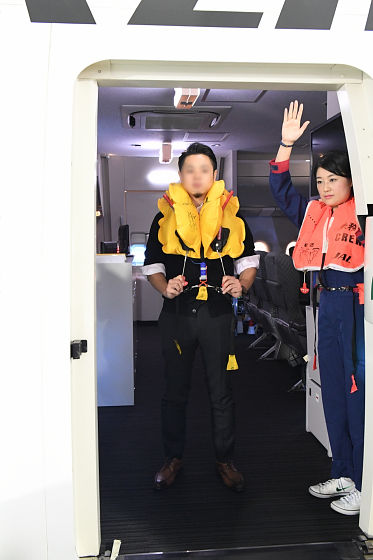
Looking from the side like this. When it inflates, it feels a little cold air, and the bag swells tightly and the neck and face are pressed more than expected.
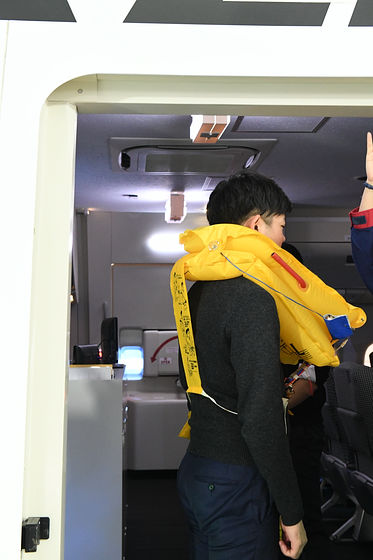
Get on the slide one after another with the life jacket inflated. Ultimately this slide will be able to be used as a boat (raft), but if you have baggage etc on escape, the number of people riding a boat will decrease. For that reason, it is strongly required that you do not leave your belongings when you escape.
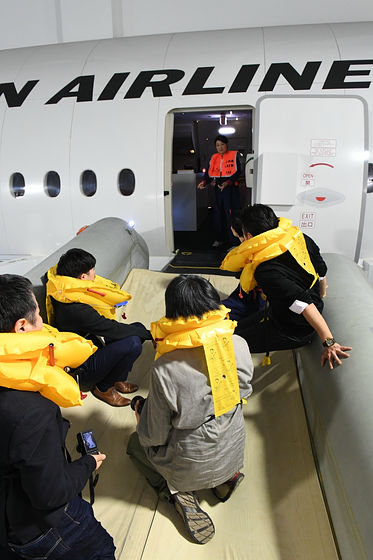
When the boat reaches capacity, when pulling this rope from the slide side ... ...
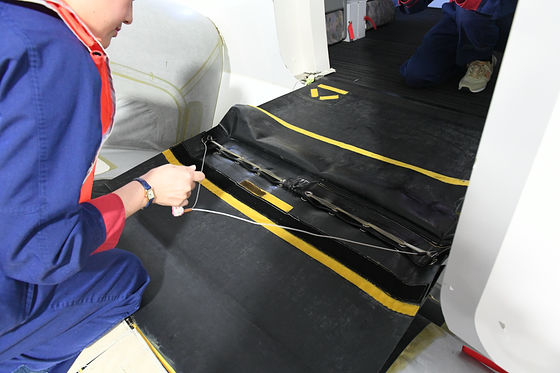
The connection with the aircraft has expired, the slide transforms into a boat.
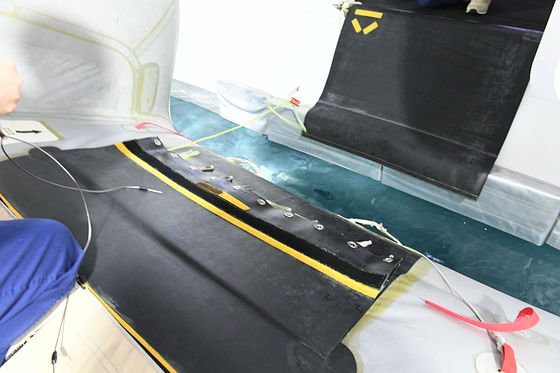
From the viewpoint of the cabin, the situation at this time. When the crew pulls the rope ......
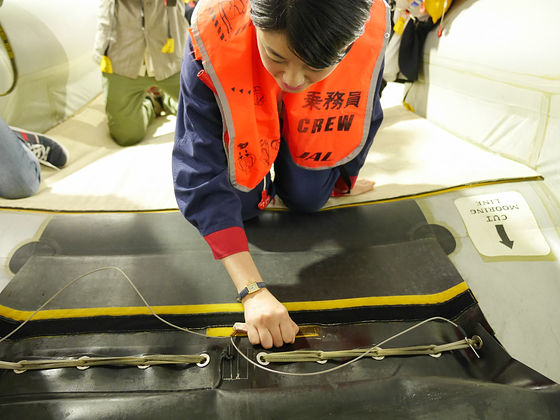
The connection broke off, and the boat left the plane. If you do not separate the boat from the aircraft as much as possible, there is a danger of sinking with the aircraft going down, so prompt work is required.

With this, the boat carrying the passengers and flight attendants became the tay which began to float in the ocean. The next task is to prepare the necessary tools while waiting for a rescue. Because there is a part written as "SURVIVAL KIT" etc at the tip of the boat ... ...
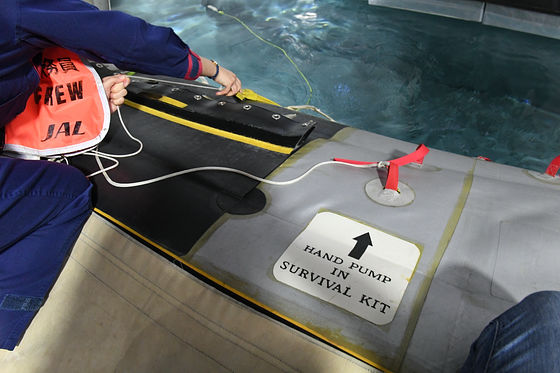
Pull on the rope connected here, pull up the yellow bag "survival kit".
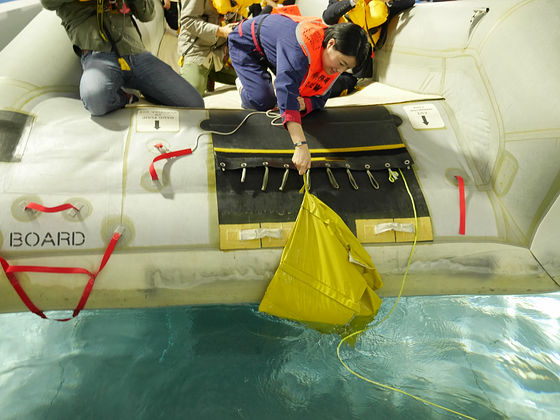
As will be described later, this includes various tools, foods, medicines, etc. necessary for survival.
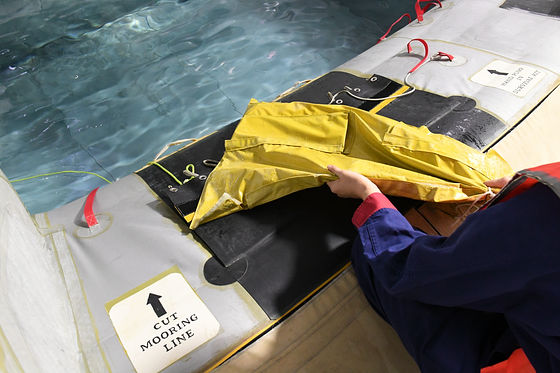
Also, the boat is also equipped with things like orange floating rings like this.
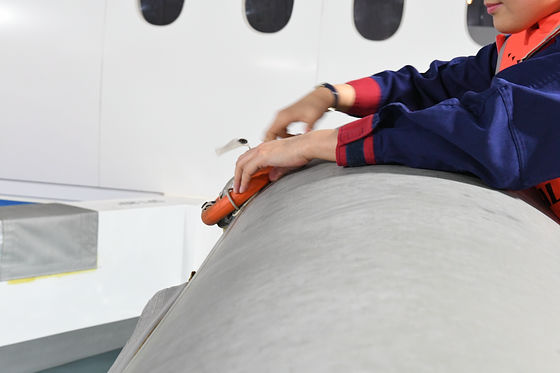
The rope is attached to this floating wheel, it seems to be used as a floating wheel to connect a boat by throwing it to another boat and pulling it together and helping people who fell accidentally to the sea .
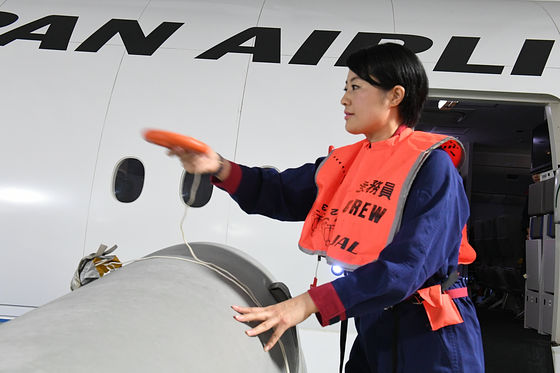
By the way, the life jacket I used for the demonstration is a type called "dual chamber" where there are two bulging parts, but the mainstream current is the type called "single chamber". Although it is a single chamber, the buoyancy is better than the conventional dual chamber.

In order to inflate life jacket, CO2 filled with carbon dioxide "CO2" is installed. If it is a road bike ride it will come with a pin, it is the same type as the portable bomb "CO2", which is used when putting in the bicycle air on the go.
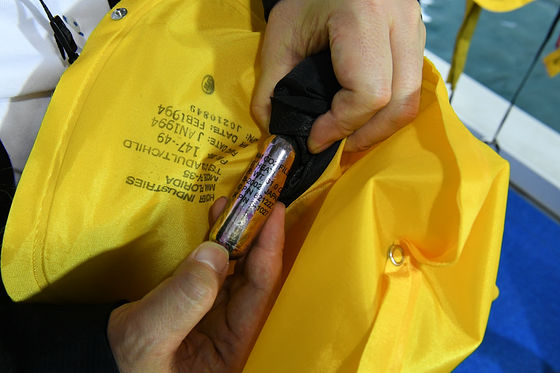
In addition, power is built in the blue part ... ...
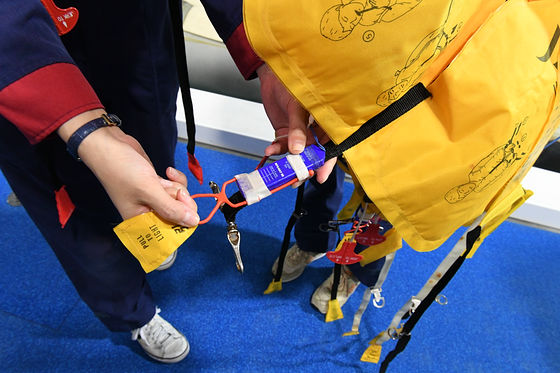
By shining the LEDs, ingenuity is given to make it easier to detect even at night.

In the survival kit, equipment including a tent on boat is also included in this way.
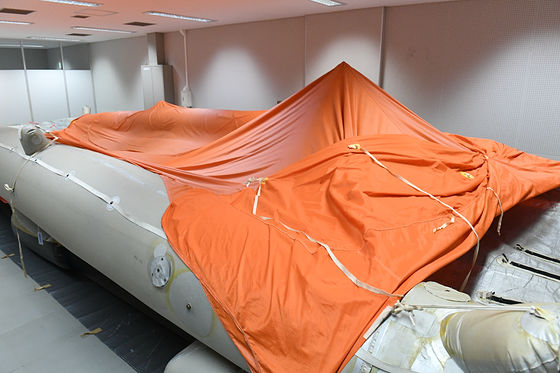
By stretching an orange tent roof and standing one post in the center, it protects people inside from the sun's direct sunlight and rain breeze. Although comfort may not be so high, it seems to be able to secure only the environment necessary for survival.
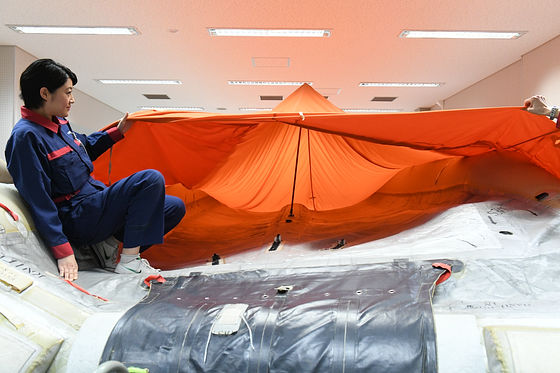
In addition, the survival kit is equipped with a yellow bucket like this.
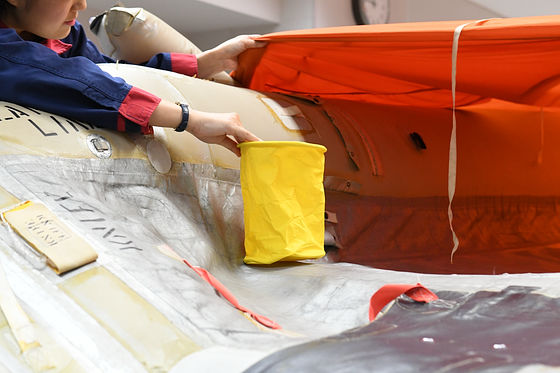
By placing this bucket under the pipe extending from the roof of the tent, we collect the rain that has fallen so that it can be used as fresh water. In this way, even if you accidentally arrive at the sea and drifted, the equipment for surviving until the rescue is reached is actually mounted on the airplane.
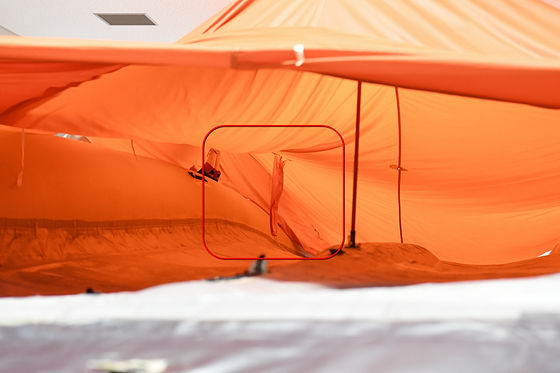
The survival kit says that this kind of equipment is stored.
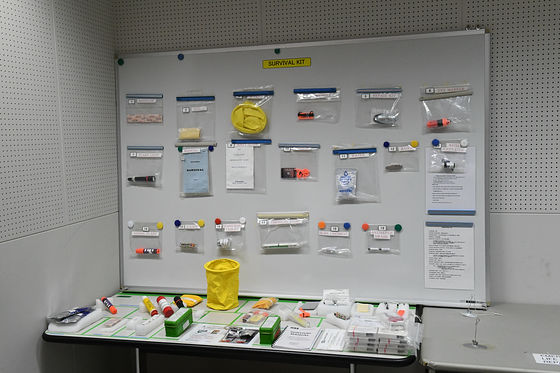
A band aid (1) used for minor scratches, a compressed sponge (2) which swells when water is applied, a flash light (7) used as a light, a survival manual (8) in which various ways of surviving are written
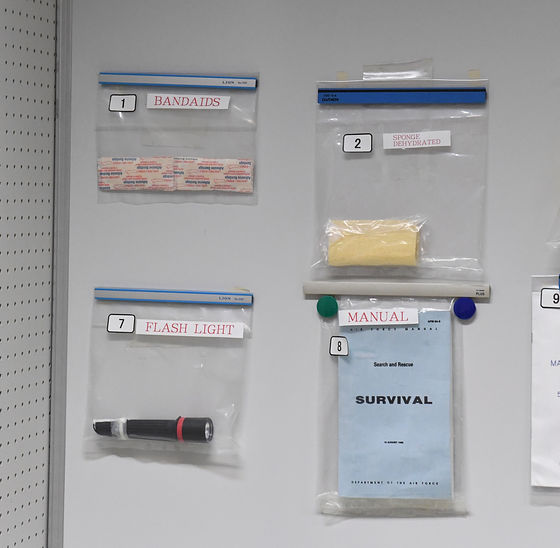
A bucket (3) for rainwater, a whistle (4) used for instructions and the like, a raft (boat) usage guide (9), a mirror (10) for reflecting sunlight and notifying the rescue team of existence,

A repair kit (5) to repair when a hole in a boat is repaired, a die marker (6) which can change the color of the surrounding water by dipping in sea water, a water marker (6), water (11), a knife (12) , Tablet for water purification (13)
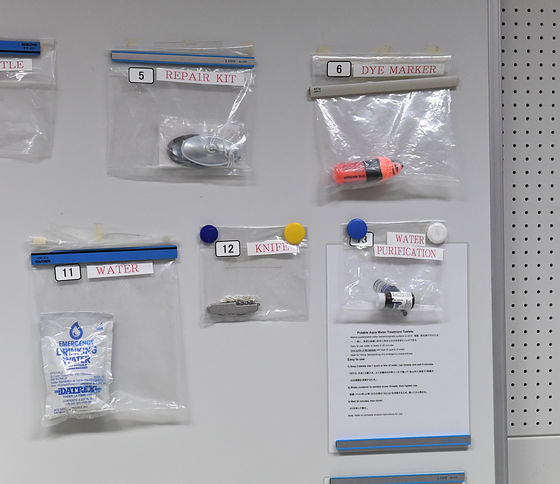
Signal flame tube (14), candy (15), seasick pill (16) to inform the rescue team of the place
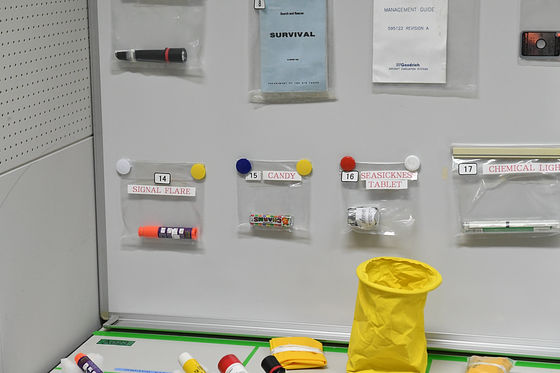
In the survival kit, supplies such as chemical light (17) like so-called "psyllium" which emits light when pointing, poultice for burns (18), sterilized swab (19) are provided.

The contents of the survival manual are quite serious "survival technique", and like this, "fish which should not be eaten because there is poison" is introduced with illustrations ......
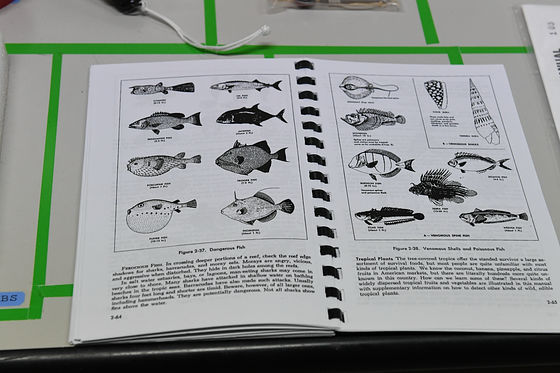
How to dig a hole in the soil and get the fresh water by placing stones etc on the vinyl sheet, etc. Even if raft drifted on the uninhabited island, it was full of know-how for surviving.
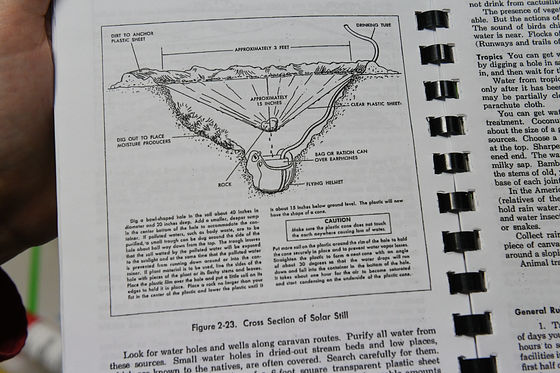
The escape procedure when an airplane arrived at the sea and so on was like this. Next, I tried the escape procedure when I landed on land.
◆ Experience 2/4: I actually experienced escape · Part 2 "Case of land escape"
When escaping from the ground, you will escape to the outside by sliding down the developed slide. In this facility, it is also possible to reproduce the atmosphere when fire, etc. occurred in the time of arrival by filling in the machine with smoke.
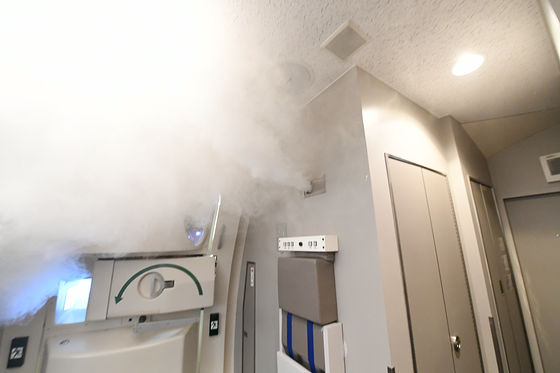
Inside of the training mockup filled with white smoke. Of course, it is not actual smoke but smoke used in concert etc is burned, so there is a unique sweet smell in the cabin.
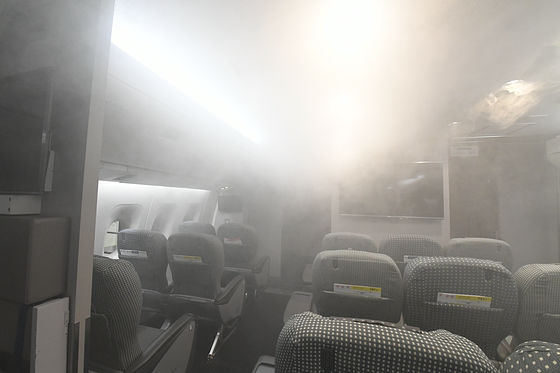
Fujiwara who opens the door after doing shouting like "OK! OK! The opening doors are those of the Boeing 777 aircraft, and this mockup seems to be equipped with various types of doors for each exit.
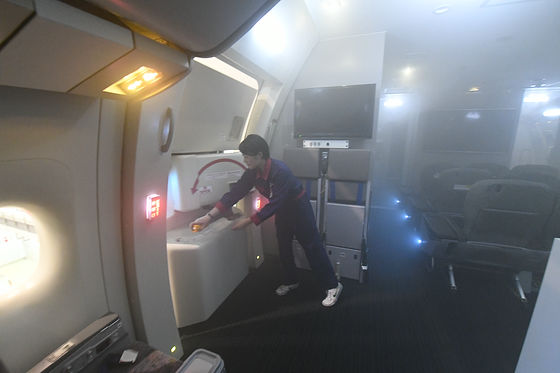
By simulating smoke, it is realistic training of passenger guidance when smoking. The height of several tens of centimeters from the floor is the part where smoke does not reach, so the cabin crew bent over to the floor and use a flashlight to urge passengers to escape "Doors are here ~!" Also, you can see that the seat facing the aisle is shining the legs.
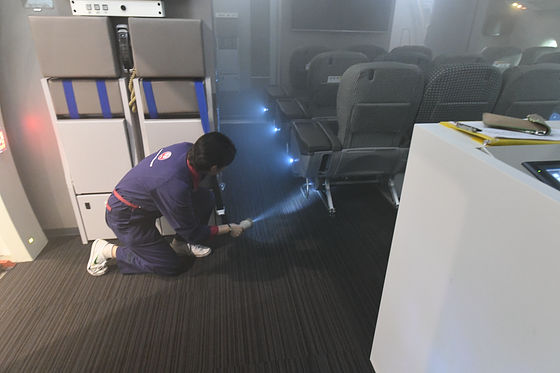
At the same time, small megaphone etc. can be used. Anyway, when an emergency occurs, prompt escape is required, so training is conducted to guide passengers with various tools.
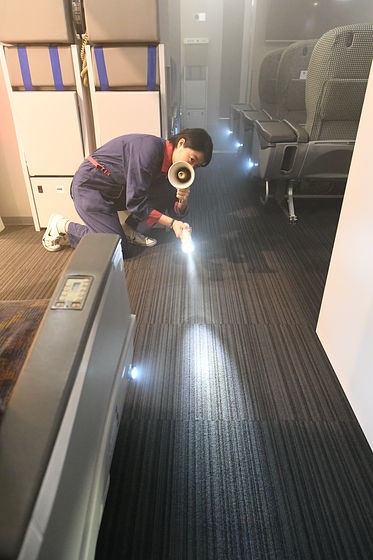
As soon as you come to the door, the moment the slide slides down arrives. It is unexpectedly convinced that there are passengers who hesitate to slide, because they are shocked "Oh," that there is height.
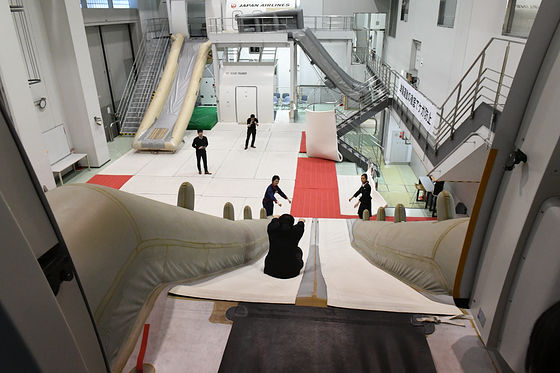
Never escape! Grasp both hands and raise it to the height of the shoulder, keeping the forward leaning posture and sliding down. If you tilt your body backwards at this time, it will lead to accidents such as speeding up with the same principle as skiing, falling under the slide. If you encounter an opportunity to slide on a slide, say "Body is forward leaning" and slide and slide.
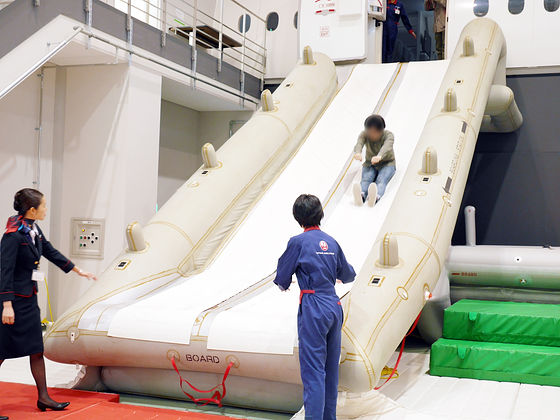
Here, Mr. Fujiwara will show off "professional skill". Go up a little lightly ......
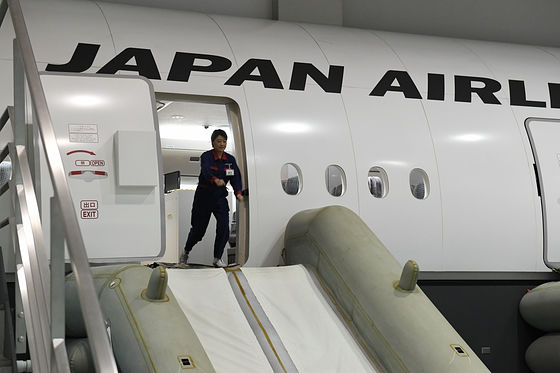
Jump lightly with Pyon and take the escape posture in the air as it is.
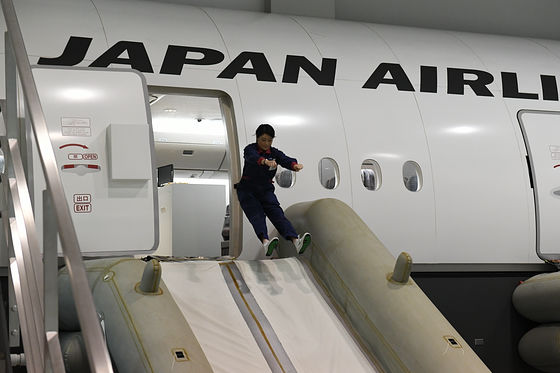
I landed on the slide as it was, and slid down keeping my posture.
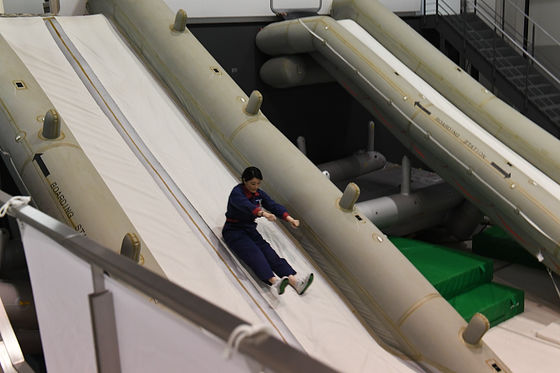
Again from another angle. "Hyopo" jumped up ... ...
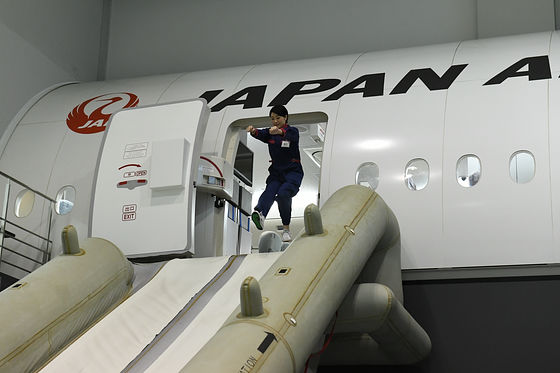
Continue to slide down the slide.
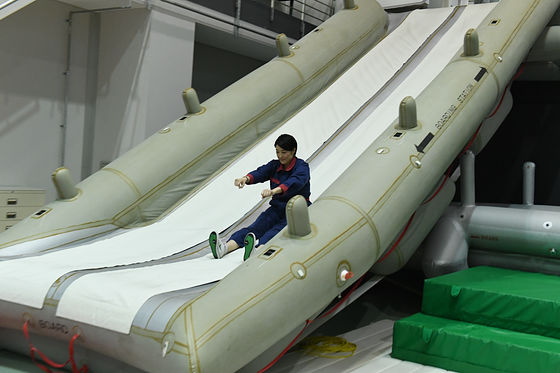
After landing, it's quickly ......
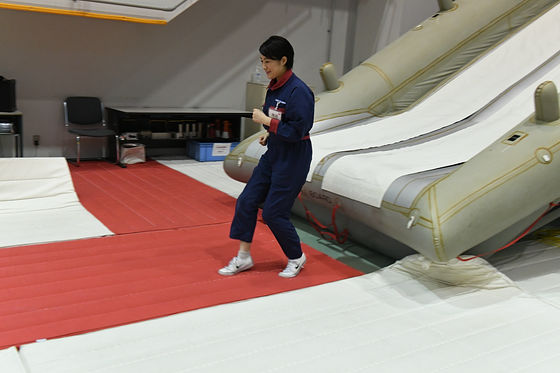
Keep moving away from the slide with "Tetete" running fast. This is necessary to get away from dangerous aircraft and not to disturb other passengers slipping one after another.
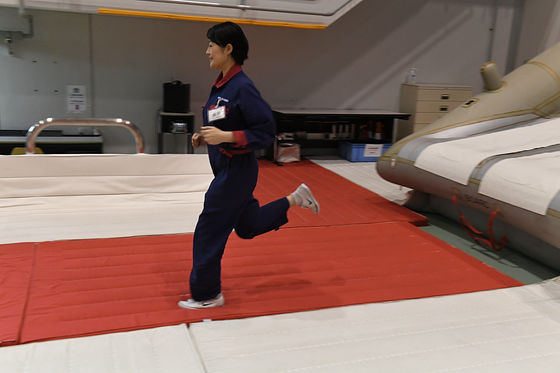
Because it becomes intense movement, mats are spread in the training area, and it was designed to prevent accidents during training.
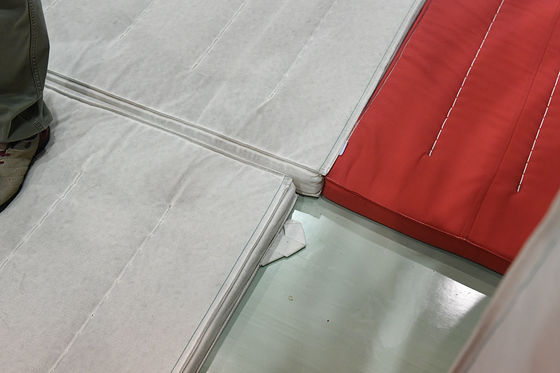
◆ Experience 3/4: Exercise that is not escape but assumes emergency · Oxygen mask
What is supposed to be a trouble occurring in an airplane flying over the sky is a situation called "sudden depressurization" where the air pressure in the airplane drops sharply. When an airplane flying near an altitude of 10,000 meters suddenly decompresses, breathing becomes impossible and most people lose consciousness in tens of seconds. Therefore, an oxygen mask is always installed on the head of a passenger aircraft seat, so that masks come down from the top when sudden decompression occurs.
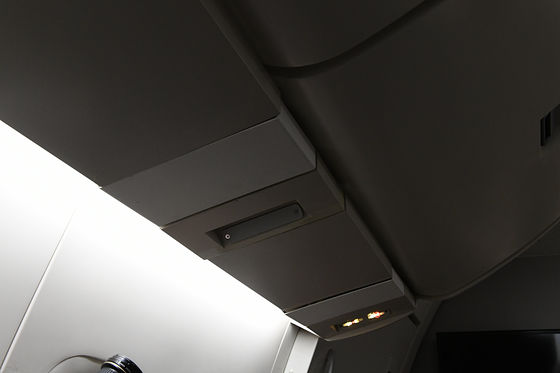
When the oxygen mask gets off, it looks like this. In the case of this sheet, two masks came down for two rows, but in most seats there is a mask of "actual row plus 1". This is supposed to be a case where an infant hugged by a parent is sitting, and it seems that the mask surely spreads even in such a case.
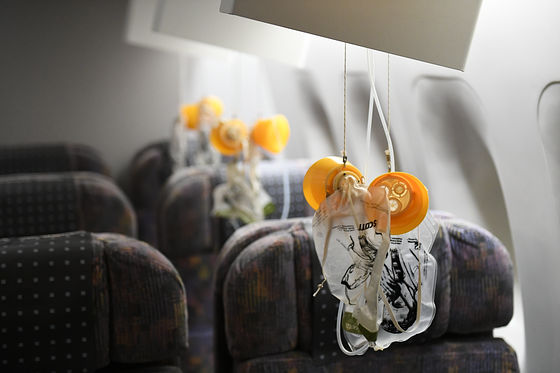
Illustration with mask installation
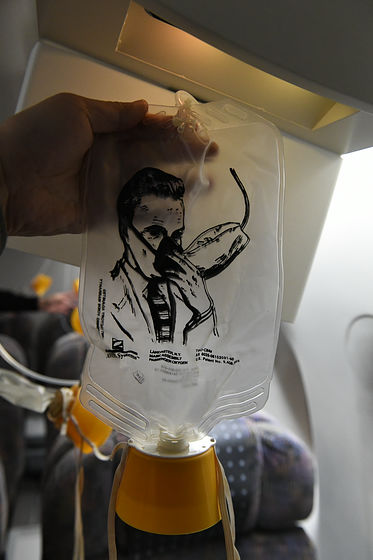
There were various types of masks, but this mask had three valves attached by intake and exhaust.
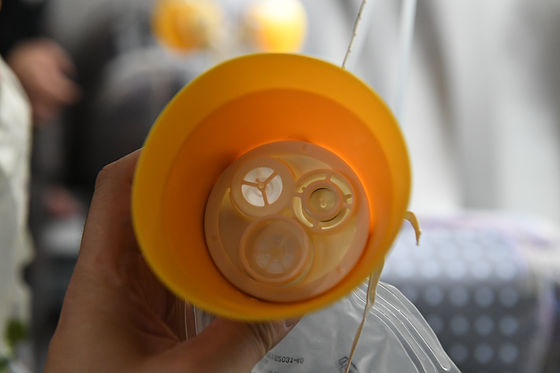
◆ Experience 4/4: "rescue food" tasting review prepared for emergency
In addition to various equipments and survival kits, passenger aircraft are equipped with "rescued food" to provide emergency supply. Normally I do not see it, but when an emergency occurs, a flight attendant is supposed to be departing from the plane with rescued food that entered this can.
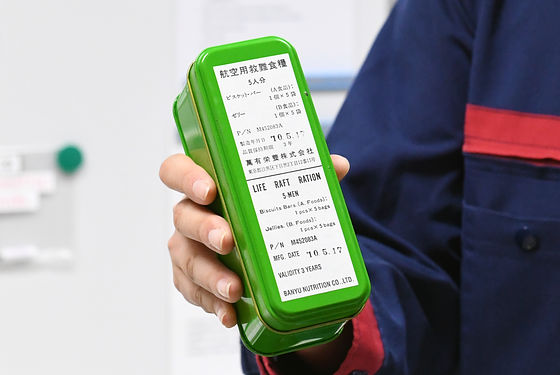
Inside, there are five kinds of large and small two types of food. This is for five people.
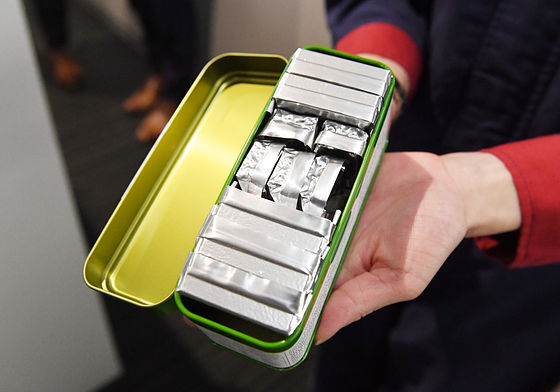
Breakdown is "biscuit" and "jelly" are two kinds.
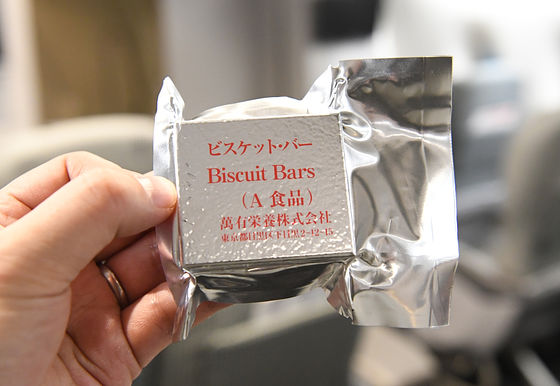
Food is vacuum packed with aluminum bags, and the expiration date for three years from the manufacture is set.
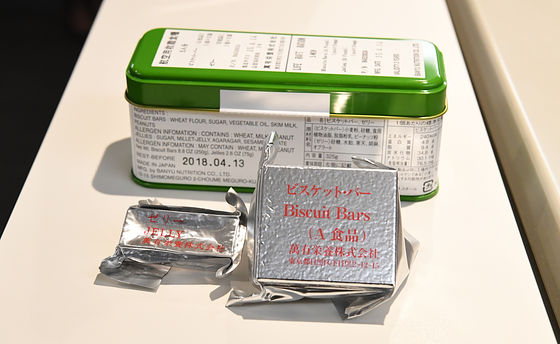
I opened the biscuits. It looks like a tile made of ceramic rather than biscuits, and it seems that it does not seem to be a food to eat.

But this is an important nutrition source in case of emergency. The taste has become a sweet taste beyond imagination, and it seems that it seems that you can effectively ingest calories. When it is included in the mouth, it has become a sense of fineness with a fine grain feeling crumbling and crumpled, it was a food similar to "Wasan Bin" and "Chin Sushu" rather than "biscuits". Incidentally, wheat flour, sugar, edible vegetable fat, skim milk powder, peanut powder. Peanut powder is included in raw materials, but in Japan Airlines, we are gradually replacing the in-flight emergency hood with a peanut-free one.
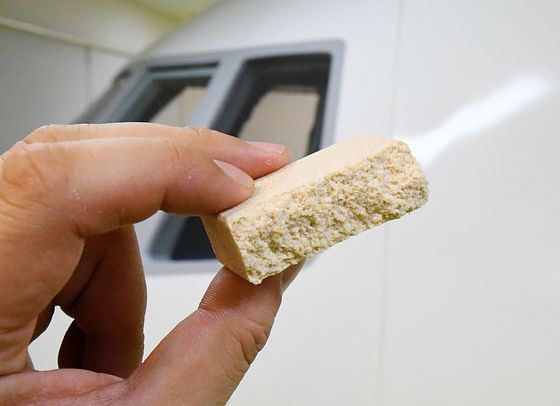
Although it is "jelly" on one side, this is completely losing if imagining ordinary jelly. Food ingredients with sesame are sandwiched between translucent jelly-like plates. Most people have eaten food, but when you try to eat it actually the sweetness is intensified but unexpectedly it was like a Japanese sweet, and it was able to eat without any discomfort in particular. Rather, the flavor of a savory taste became a taste that felt a trace and make it feel a lingering finish. Raw materials are sugar, syrup, agar, sesame, oblate.

Nutritional elements per piece look like this. One biscuit is 240 kcal, jelly is 59 kcal, and it is one serving, totaling 299 kcal.

I thought, "Is there food like this ...?" And when I looked into various things, I found out that the same thing as this food actually is on the market. It is also described in the packageBanyan Nutrition Co., Ltd.It is possible to purchase an emergency food of the same content "rescue food ER5 ingestion SOLAS treaty compliance" for 1749 yen per can. Being a perfect item for a genuine Hikoki mania, it may be the best dish as food to be kept in ordinary households to prepare for disasters.
Rescue food ER5 ingestion Complies with SOLAS treaty

When I saw the training site like this, the scheduled time finished in no time. In addition to being able to see the facilities that we can not see in detail, we also realized that "training and equipment so far have been prepared for the safe operation of passenger aircraft," as well as JAL It was an interview that the airline company that is doing more convincing power to the motto "Customer safety is the first". The following situation is a scene of training for JAL Group staff who was doing during interview. In this way, efforts to raise awareness of the entire group were carried out.
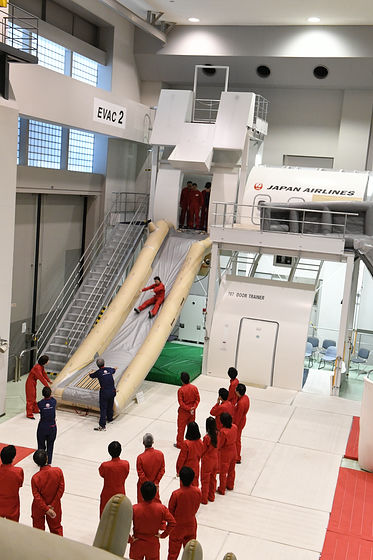
Related Posts:







